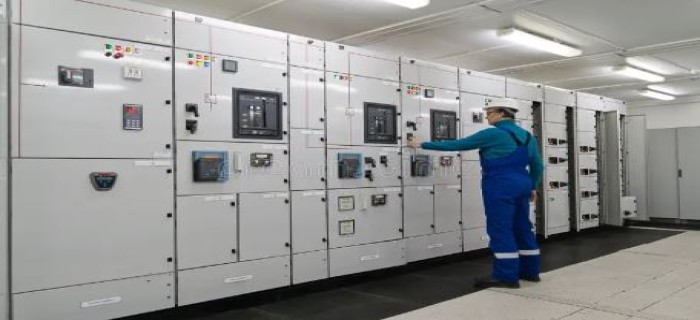
SWITCHGEARS & CONTROLGEARS - Low Voltage Switchgears & Controlgears Assemblies – Applicable Standards & Future
09 Nov 2024
ABSTRACT:
Low voltage switchgear and controlgear assemblies are crucial components in electrical distribution systems. They play a vital role in controlling, protecting, and isolating electrical equipment and circuits in various applications, ranging from industrial to commercial and residential settings. This overview will cover the characteristics, functions, and relevant standards associated with these assemblies, with a particular focus on the IEC 61439 series.
KEY WORDS: Low Voltage, Switchgear, Controlgear, Assemblies
INTRODUCTION
Low voltage switchgear and controlgear assemblies are defined as assemblies that include devices for switching, protecting, and controlling electrical circuits and equipment at low voltage levels, typically below 1,000 V AC or 1,500 V DC.(Refer figure 1)
Fig.1 Low Voltage Switchgear and Controlgear Assembly
Control and switchgear panels in substations are assemblies of control devices, instruments, and monitoring equipment. They are used to control and manage electrical power systems, ensuring safe, reliable, and efficient operation. Control panels can include a variety of components, such as circuit breakers, relays, meters, switches, and communication interfaces.
Their primary function is to provide operators with the means to monitor system parameters, control equipment, and respond to operational anomalies.
Key Functions include:
1. Control: Regulating electrical flow to various equipment and systems.
2. Protection: Safeguarding circuits against overloads, short circuits, and other electrical faults.
3. Isolation: Providing safe disconnection of electrical equipment for maintenance or emergency situations.
4. Distribution: Distributing electrical power to different loads in an efficient manner.
Common components found in low voltage switchgear and controlgear assemblies include:
• Circuit Breakers: Devices that automatically interrupt the flow of current in case of a fault.
• Contactors: Electromechanical switches used for controlling power circuits.
• Relays: Devices that control circuits based on input conditions.
• Busbars: Conductors that distribute power to multiple circuits.
• Fuses: Safety devices that protect circuits from overcurrent conditions. A typical switchgear and controlgear assembly in the substation is shown in figure 2.
Fig.2 ACDB Panel in Substation
2.0 RELEVANT STANDARDS FOR LV S&C ASSEMBLIES
Several standards govern the design, manufacturing, testing, and application of low voltage switchgear and controlgear assemblies.
The most significant standards include:
2.1 IEC 61439 SERIES
The IEC 61439 series is the primary international standard for low voltage switchgear and controlgear assemblies, consisting of multiple parts:
• IEC 61439-1: General Rules: This part outlines the general requirements and definitions applicable to low voltage switchgear assemblies. It covers topics such as design verification, performance characteristics, and documentation requirements.
• IEC 61439-2: Power Switchgear and Controlgear Assemblies This part provides specific requirements for power switchgear assemblies, including design, construction, testing, and performance criteria.
• IEC 61439-3: Distribution Boards for Electrical Installations This standard specifies requirements for distribution boards, focusing on safety, functionality, and performance.
• IEC 61439-4: Assemblies for Power Distribution in Public Networks This part outlines requirements for assemblies intended for public electrical distribution systems.
• IEC 61439-5: Assemblies for Power Distribution in Industrial and Commercial Installations This standard addresses requirements for assemblies used in industrial and commercial applications.
• IEC 61439-6: Assemblies for Low-Voltage Motor Control Centers This part specifies the requirements for motor control centers, including design and testing criteria.
• IEC 61439-7: assemblies for specific applications such as marinas, camping sites, market squares, electric vehicle charging stations.
2.2 IEC 60947 SERIES
The IEC 60947 series covers low voltage switching and control devices. Key components relevant to switchgear and controlgear assemblies include:
• IEC 60947-1: General Rules
• IEC 60947-2: Circuit Breakers
• IEC 60947-3: Switches and Disconnectors These standards provide essential information on device performance, safety, and testing methods.
2.3 IEC 60204-1:
SAFETY OF MACHINERY This standard addresses electrical equipment of machines, providing safety requirements and guidelines that are often applicable to controlgear assemblies used in industrial environments.'
2.4 IEC 61000:
ELECTROMAGNETIC COMPATIBILITY (EMC) Critical for ensuring that devices meet regulatory requirements for operation in various environments without causing or being affected by electromagnetic interference.
2.5IEC 60529:
DEGREES OF PROTECTION This standard specifies the degrees of protection provided by enclosures for electrical equipment against the ingress of solid foreign objects and moisture. It is useful in selecting enclosures for equipment based on environmental exposure.
2.6 IEC 60439
SERIES IEC 61439, specifies requirements for low-voltage switchgear and controlgear assemblies .Compliance with these standards ensures products meet safety and performance regulations.
2.7 IEC 60255
This standard covers the measuring relays and protection equipment. It specifies the general requirements for the performance, testing, and reliability of relays used in electrical protection and control systems.
2.8 ISO 9001:
QUALITY MANAGEMENT SYSTEMS While not specific to electrical assemblies, ISO 9001 sets forth criteria for quality management systems. Compliance with this standard can enhance the reliability and quality of switchgear and controlgear assemblies.
3.0 VERIFICATION FOR RELIABILITY & SAFETY IEC 61439-1 is part of a broader set of standards aimed at ensuring the reliability and safety of electrical assemblies. The standard defines the requirements for design verification, which confirms that the assembly has been designed to meet specified requirements, including thermal, mechanical, electrical, and dielectric performance.
3.1 Importance of Verification
Verification is crucial for ensuring the integrity and safety of electrical systems. It helps in:
1. Safety Assurance: Reduces the risk of electrical hazards.
2. Regulatory Compliance: Ensures compliance with national and international regulations.
3. Performance Consistency: Verifies that products perform as intended under specified conditions.
4. Customer Confidence: Builds trust in the manufacturer’s quality assurance processes.
3.2 Types of Verification IEC 61439-1 outlines several verification methods, which can be categorized as follows:
1. Design Verification
2. Type Testing
3. Routine Testing
4. Factory Production Control (FPC)
1. Design Verification:
Design verification ensures that the assembly’s design meets the requirements specified in the standard. It is primarily concerned with assessing the design calculations and simulations, rather than physical testing.
Fig.3 Short-circuit Withstand Capability Test
2. Type Testing:
Type testing involves physical testing of a prototype or a sample of the assembly to verify that it meets the performance requirements laid out in the standard. Type tests confirm the assembly’s performance in real-world conditions.
Categories of Tests:
• Dielectric Properties: Tests for insulation resistance, withstand voltage, and other dielectric characteristics.
• Thermal Performance: Tests to measure temperature rise under specified load conditions.
• Short-Circuit Withstand Strength: Tests to ensure the assembly can handle short-circuit conditions without failure. (Refer figure 3)
• Mechanical Properties: Assessment of the assembly’s ability to withstand mechanical stresses.
• Ingress Protection and EMC : Tests to ensured withstand capabilities against environmental effects and Electromagnetic effects. (Refer figure 4)
Fig.4 ingress Protection Test
3.3 Routine Testing:
Routine testing is performed on each assembly during production to ensure that the manufacturing process has consistently produced assemblies that meet specified requirements.
Tests Included:
• Visual inspections for physical defects.
• Verification of key parameters such as dimensions and markings.
• Electrical tests, including insulation resistance and functional tests. These tests are conducted for every unit or a statistically representative sample.
3.4 Factory Production Control (FPC):
FPC is a system that ensures the consistent quality of assemblies produced in a factory setting. A systematic approach to ensuring that products are manufactured to meet specified requirements.
Main Components are:
• Quality Management System (QMS): Ensures compliance with relevant quality standards.
• Documented Procedures: Includes instructions for processes, inspections, and testing.
• Personnel Training: Ensures that staff are trained to carry out their roles effectively.
A robust FPC can significantly reduce the need for extensive type testing since it assures that the manufacturing process is capable of consistently producing compliant products.
4.0 FUTURE CONSIDERATIONS
The landscape of low-voltage switchgear and controlgear assemblies is continuously evolving, driven by advancements in technology and changing market demands. Future developments may include:
1. Integration of Smart Technologies: The rise of smart grids and IoT devices will necessitate updates to IS/IEC 61439 to accommodate new functionalities and performance criteria.
2. Sustainability Focus: Increased emphasis on environmental sustainability may lead to new requirements regarding energy efficiency and material sourcing.
3. Digitalization: The use of digital twins and simulation technologies may become more prevalent, influencing design verification processes.
5.0 CONCLUSION
Switchgear and Controlgear assemblies are essential components of modern electrical power systems, and adherence to applicable standards and codes is vital for ensuring their reliability, safety, and performance. The landscape of standards is broad, encompassing international, national, and industry-specific guidelines that shape the design, installation, and operation of these panels. Verification as per IEC 61439-1 is a critical aspect of ensuring that low-voltage switchgear and controlgear assemblies are safe, reliable, and effective. By following these verification protocols, manufacturers can enhance product quality, ensure regulatory compliance, and ultimately build trust with end-users. This process not only safeguards public safety but also reinforces the integrity of electrical systems globally. As technology continues to evolve, the standards governing control and relay panels will also need to adapt to address new challenges, including smart grid integration, sustainability, and cyber security. Compliance with these standards not only promotes safety and reliability but also enhances the efficiency and effectiveness of electrical power systems, contributing to a more resilient and sustainable energy future.



leave your comment